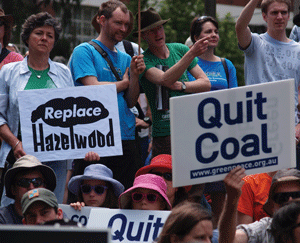VCAT upholds police records rights

Do government record-keeping requirements triumph over an individual’s right to anonymity? A recent case heard by the Victorian Civil and Administrative Tribunal (VCAT) came down on the side of the authorities.
In the case of Caripis v Victoria Police (Health and Privacy) [2012], an environmental activist objected to being photographed by police while protesting against the ongoing operations of the Hazelwood coal power station.
Lisa Caripis joined other protesters in a protest at Hazelwood power station on 10 October 2010, where Victoria Police filmed and took photographs of the event and retains those images.
Ms Caripis complained that the retention of images of her is an interference with her privacy, even though the police had no details on her identity to relate to the photographs and video they took.
They argued that “they are required by the Public Records Act to preserve the records in question and that the Tribunal has no jurisdiction to consider the issue of unlawfulness under the Charter.”
Senior Sergeant David Watson told the tribunal there were regular protests against the power stations in the Latrobe Valley, where 90% of Victoria’s power is generated.
Superintendent Therese Walsh said that in the light of frequent protests and regular illegal activity by protesters, “effective police management in the Latrobe Valley must involve support for the power stations to conduct their business”.
This was the reason given for gathering footage on the day of the Hazelwood protest, which according to Senior Sergeant Watson is now “held on a disk in a locked cupboard at the “Morwell Crime Desk”.
While Ms Caripis maintained her privacy was violated by the contents of Senior Sergeant Watson’s locked cupboard, Victoria Police argued that Section 19 of the Victorian Public Records Act 1973 “provides that it is an offence to damage or destroy a public record unlawfully and that destruction in accord with a standard established under section 12 of that Act is lawful.”
VCAT considered a range of relevant legislation, including Victoria’s Charter of Human Rights and Responsibilities Act (2006) which states that “Every person has the right of peaceful assembly.” There were also appeals to European Convention on Human Rights.
In her conclusion, VCAT deputy president Bernadette Steele noted “I was not persuaded that retention of the images, in circumstances where many photographs were taken by all sorts of people that day, where some of those still appear on public websites and where the Respondent has no other data about the Complainant, not even her name, was inconsistent with the exercise of her rights to freedom of expression and peaceful assembly.”
After a lengthy consideration of clause and sub-clause of the Public Record Act 1973, VCAT concluded, “there is no authority for it to be disposed of or destroyed …
“Accordingly the only authority given to the Respondent (Victoria Police) to dispose of or alter the records is the standard in class 10.2.1, which permits disposal after 7 years.”
“Considering all the evidence and given the context in which the footage was collected and the likelihood of other protests in the Latrobe Valley, I was satisfied that the Respondent needs to retain the footage for the purposes of intelligence, in the sense that it may be useful in future. There was no evidence that the Respondent has any particular interest in retaining the images of Ms Caripis herself any more than any other person in the crowd.”
It was also noted that “the Complainant agreed that many people took photographs of the 2010 protest and uploaded them to social media and that there is still an extensive gallery on the website “Flickr”.”
Ms Caripis said she had not checked whether her image appeared amongst them and agreed also that while she was surprised by the number of police at the protest she was not surprised that media and police took film and photographs of the event.
“This, together with her knowledge that others could retain and publish the photographs (obvious from her familiarity with the advertisements about the protest) and her knowledge that 350.0rg intended to publish photographs, indicate that the Complainant could not have had a reasonable expectation of privacy in relation to the taking, publication or retention of photographs.”
The complaint was dismissed.
Full Judgement HERE
